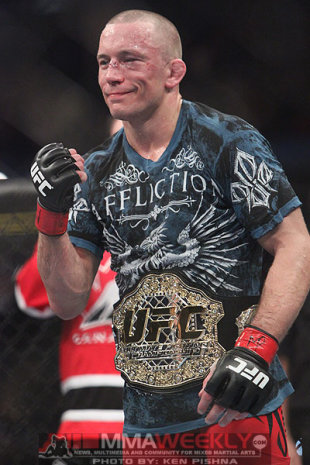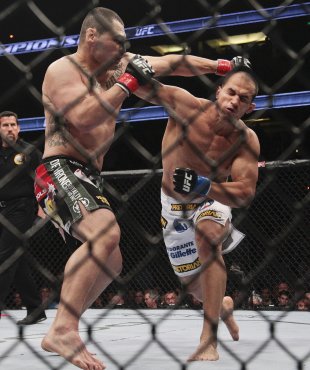One of Dana White's favorite sayings is, "Every day I wake up, there is crazy [expletive] I have to deal with."
It's the price one pays for the kind of success the UFC president has enjoyed in the last decade-plus. In a little more than 11 years, he's turned a company on the verge of bankruptcy into one estimated to be worth more than $2 billion.
His partner, casino mogul Lorenzo Fertitta, wouldn't assign a value to the UFC, but put it in stratospheric levels during a 2011 interview with the New York Times.
"I feel pretty comfortable saying we're the most valuable sports franchise on the planet, more than Manchester United, more than the New York Yankees, more than the Dallas Cowboys," Fertitta told the Times.
Even if Fertitta is not right, it's mind-boggling that he can even mention the UFC in the same sentence with those iconic sports franchises to a reporter from the New York Times and not be laughed out of the room.
What White has done in these last 11 years to lead that surge is as remarkable in its own way as what the late Steve Jobs did in masterminding Apple's rebound from near-extinction after his return to the then-troubled computer manufacturer in 1997.
But as White prepares to seriously promote UFC 152 at the Air Canada Centre in Toronto on Sept. 22, he must deal with a stark reality: His list of headline-worthy stars is shrinking rapidly.
Despite the UFC's multi-year deal with Fox, it is still a pay-per-view company first and foremost. It relies on its stars to sell tickets and pay-per-views and create job opportunities and prosperity for those down the card.
But as 2012 enters its homestretch, there is plenty for White to be concerned about.
His biggest draw, welterweight champion Georges St-Pierre, hasn't fought in 16 months and won't be in the cage again until November. Nobody knows if he'll ever be the same as he was before his knee injury.
White's next biggest attraction, middleweight champion Anderson Silva, is 37 and has already been making noises about retirement.
And his emerging superstar, light heavyweight champion Jon Jones, is embroiled in controversy and being blasted from all directions.
It's not easy to determine exactly what makes a fighter a pay-per-view star, but it is clear that it takes a star to sell a pay-per-view.
That's why you didn't hear flyweight contender Joseph Benavidez complaining too much when Jones was added to the UFC 152 card, pushing him out of main-event status. He knew having Jones atop the bill would create more interest and push more sales.
[Also: Baltimore's Camden Yards basks in first pennant race in two decades]
White has greatly expanded the sport's hard core fan base, and so the floor for sales is much higher than it was even five years ago.
But hardcore fans are only a small percentage of the overall audience. A successful pay-per-view comes as a result of convincing casual fans to buy.
In that sense, it's no different than the challenge facing President Obama or Republican presidential nominee Mitt Romney in winning the election. They don't have to worry about getting the votes from their base; they have to convince the undecided and those in the middle to support them.
White and Fertitta have to find a way to bring along fighters who will replace Silva and St-Pierre and help with that crossover appeal.
Part of the reason for the UFC's interest in the Fox deal, besides the money they received, was the ability to use the shows on Fox to make its fighters more recognizable to the channel surfers and casual sports fans.
It's been a mixed bag, though. Fuel TV might as well be renamed the "UFC Network," for the huge amount of content it carries, but it doesn't have wide distribution yet. There are many major cable systems that still don't carry Fuel. No matter how great the content is, if the customers can't see it, it does no good.
Fox and FX have no such distribution issues, and both are in excess of 100 million homes. Despite that, the four shows on Fox so far haven't been ratings home runs. The Nov. 12 opener was a solid performance, but the UFC got a bad break when the heavyweight title match between Cain Velasquez and Junior dos Santos lasted just a minute.
Knockouts happen, but a long fight would have given the sport much more exposure and would likely have led to an increase in the fan base. But someone who tuned in for the first time on Nov. 12 had to have been turned off when it ended so quickly. There was 60 minutes of hype and then just 60 seconds of action.
The next three shows, featuring Rashad Evans versus Phil Davis in January, Nate Diaz against Jim Miller in May and Mauricio "Shogun" Rua against Brandon Vera in August, did all right with the UFC's base, the 18-to-34 male demographic, but didn't expand beyond that.
The May show went up against the Floyd Mayweather-Miguel Cotto boxing pay-per-view, while the Rua-Vera fight was on opposite the London Olympics.
The string of bad programming matchups will continue in December for the next card. UFC on Fox 5, set for Dec. 8 in Seattle, might on paper be the strongest top-to-bottom card the UFC put on since UFC 100.
But it appears that is the date that boxing superstar Manny Pacquiao will next fight. And, to make matters worse, Golden Boy Promotions CEO Richard Schaefer has suggested that his young star, Canelo Alvarez, may fight on that night, as well, should Alvarez win his Sept. 15 bout against Josesito Lopez. That would further splinter the combat sports audience.
The result from the UFC's point-of-view is that it will hinder the growth potential for those fighting on its show because there won't be as many eyeballs on it as there otherwise might have been.
The UFC doesn't release its pay-per-view sales, though White did say publicly that UFC 148 did the second-most in company history, behind only UFC 100.
But there have been a number of bombs on pay-per-view this year, when fans simply opted to save their money. UFC 147 was a disaster and UFC 149 wasn't much better.
[Also: Klitschko brothers carved own path to heavyweight history]
That has led some to speculate that the MMA boom is on the decline.
That doesn't jibe, though, with the rock-star status that UFC fighters receive when they're in public.
It's simply a recognition of the fact that the UFC has a finite number of stars it can bank on to sell. When one of them is injured and is sidelined a long time, it depresses the entire business.
It hasn't reached a crisis mode by any means, but White knows as well as anyone the importance of finding that next generation of pay-per-view stars.
Nothing is more critical to the UFC's future.
Related video from Yahoo! Sports
Other popular content on the Yahoo! network:
• Les Carpenter: D.C.'s embrace of RG3 not all about race
• Inductee Don Nelson isn't sure he belongs in basketball Hall of Fame
• Y! Games: The worst game franchises they keep making games for































